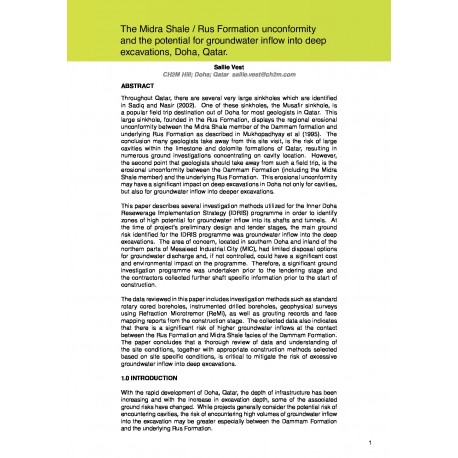Cart
0
0
No document
0,00 €
Total
Document successfully added to your shopping cart
Quantity
Total
There are 0 items in your cart.
There is 1 item in your cart.
Total documents
Total shipping
To be determined
Total
Search & filter
Search for a publication
Search & filter
The Midra Shale / Rus Formation unconformity and the potential for groundwater inflow into deep excavations, Doha, Qatar.
467_the_midra_shale___rus_format
Throughout Qatar, there are several very large sinkholes which are identified in Sadiq and Nasir (2002). One of these sinkholes, the Musafir sinkhole, is a popular field trip destination out of Doha for most geologists in Qatar. This large sinkhole, founded in the Rus Formation, displays the regional erosional unconformity between the Midra Shale member of the Dammam formation and underlying Rus Formation as described in Mukhopadhyay et al (1995). The conclusion many geologists take away from this site visit, is the risk of large cavities within the limestone and dolomite formations of Qatar, resulting in numerous ground investigations concentrating on cavity location. However, the second point that geologists should take away from such a field trip, is the erosional unconformity between the Dammam Formation (including the Midra Shale member) and the underlying Rus Formation. This erosional unconformity may have a significant impact on deep excavations in Doha not only for cavities, but also for groundwater inflow into deeper excavations.This paper describes several investigation methods utilized for the Inner Doha Resewerage Implementation Strategy (IDRIS) programme in order to identify zones of high potential for groundwater inflow into its shafts and tunnels. At the time of project’s preliminary design and tender stages, the main ground risk identified for the IDRIS programme was groundwater inflow into the deep excavations. The area of concern, located in southern Doha and inland of the northern parts of Mesaieed Industrial City (MIC), had limited disposal options for groundwater discharge and, if not controlled, could have a significant cost and environmental impact on the programme. Therefore, a significant ground investigation programme was undertaken prior to the tendering stage and the contractors collected further shaft specific information prior to the start of construction. The data reviewed in this paper includes investigation methods such as standard rotary cored boreholes, instrumented drilled boreholes, geophysical surveys using Refraction Microtremor (ReMi), as well as grouting records and face mapping reports from the construction stage. The collected data also indicates that there is a significant risk of higher groundwater inflows at the contact between the Rus Formation and Midra Shale facies of the Dammam Formation. The paper concludes that a thorough review of data and understanding of the site conditions, together with appropriate construction methods selected based on site specific conditions, is critical to mitigate the risk of excessive groundwater inflow into deep excavations.




